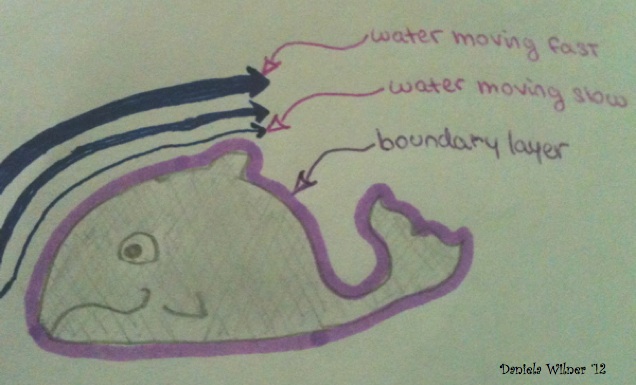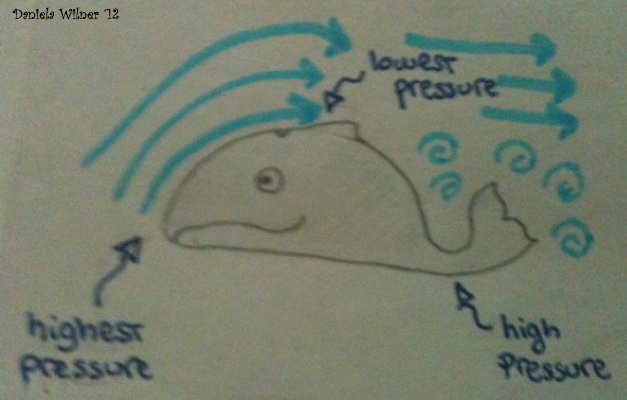Fluid Dynamics
The study of fluids in motion¤ Drag
Drag can be thought of as the force that opposes movement of a body through a fluid (Reynolds & Rommel 23). It is defined as "the rate of removal of momentum from a moving fluid by an immersed body," (Vogel, 1983) but you can look at it the other way around, where the fluid (e.g. water) takes away momentum from a moving, immersed body (e.g. a swimming seal). Needless to say, this aspect of Fluid Dynamics is very important to marine mammals. As you can imagine, losing momentum (and therefore speed, because momentum=velocity*mass) when you're trying to chase a speedy fish for dinner, or when you're trying to escape a hungry orca, is no trivial matter, not to mention the fact that you wasted a lot of energy trying to build-up that speed, energy that won't be available for other important things, like reproduction.
We will look at two types of drag acting on a swimming marine mammal: viscous drag and pressure drag.
-Viscous (frictional) Drag is caused by the viscosity of the fluid (the "stickiness between layers of fluid that slide, or are sheared, past each other"), and it happens when fluid is sheared across the surface of the animal. The thin layer of water touching the animal is called the boundary layer; it sticks to the body, moving with it and creating a velocity gradient compared to the water further out, which is moving fast relative to the animal. In this way, the layers of water are sheared past each other and across the surface of the creature, creating drag. The magnitude of this drag is proportional to the animal's surface area in contact with water as well as the viscosity of the fluid. (Reynolds & Rommel 23)
So you'd have more drag if you were swimming in syrup than if you were swimming in water, and you'll have less drag if your skin is smooth instead of wrinkly or bumpy -because smooth = less surface area-)

-Pressure (inertial) Drag: Is influenced by the viscosity and the density of the fluid, and the shape of the animal, and it is caused by differences in pressure across the body of the moving animal. When a marine mammal is moving through the water, the area with highest pressure is its face, and the one with lowest pressure is the widest part of its body, and then pressure increases again at the tail. As you might know, fluids flow spontaneously from areas of high pressure to areas of low pressure, but not the other way around. Therefore, from the face to the widest part of the animal (high to low pressure), the water will flow nice & neat in a perfect example of laminar flow, but when the time comes for the water to move from this low pressure area to the end of the tail (high pressure), we have a problem; the fluid won't stay close to the body anymore, because it doesn't "want" to go from low to high pressure, so it will separate "from the surface and head downstream, leaving a wake behind" the animal (turbulent flow). (Reynolds & Rommel 23)

A larger wake means more drag, and the best way to decrease the wake is to "reduce the separation point until it is further toward the rear end of the body;" the best way to achieve this is to gradually taper "the tail-end of the body rather than having it terminate abruptly." (Reynolds & Rommel 23) In other words, change the shape to look more spindle-like (remember that shape was one of the main factors determining the Reynolds Number and causing flow to be laminar or turbulent?)
This is why most marine mammals are shaped like this,

http://www.avalanche-center.org/Education/glossary/images/wind-flow-diagram.gif
and not like this:

http://www.math.rug.nl/~veldman/figures/blok-detail.gif
¤ Types of Flow
¤ Bernoulli's Principle


